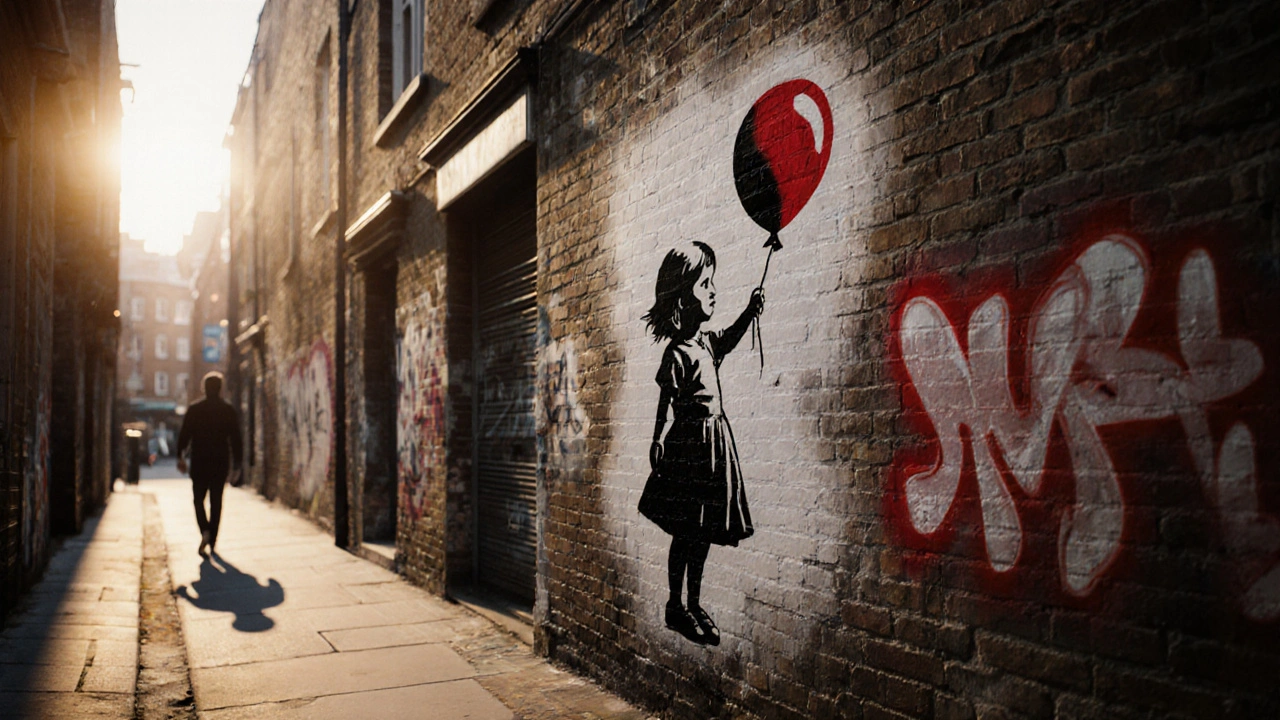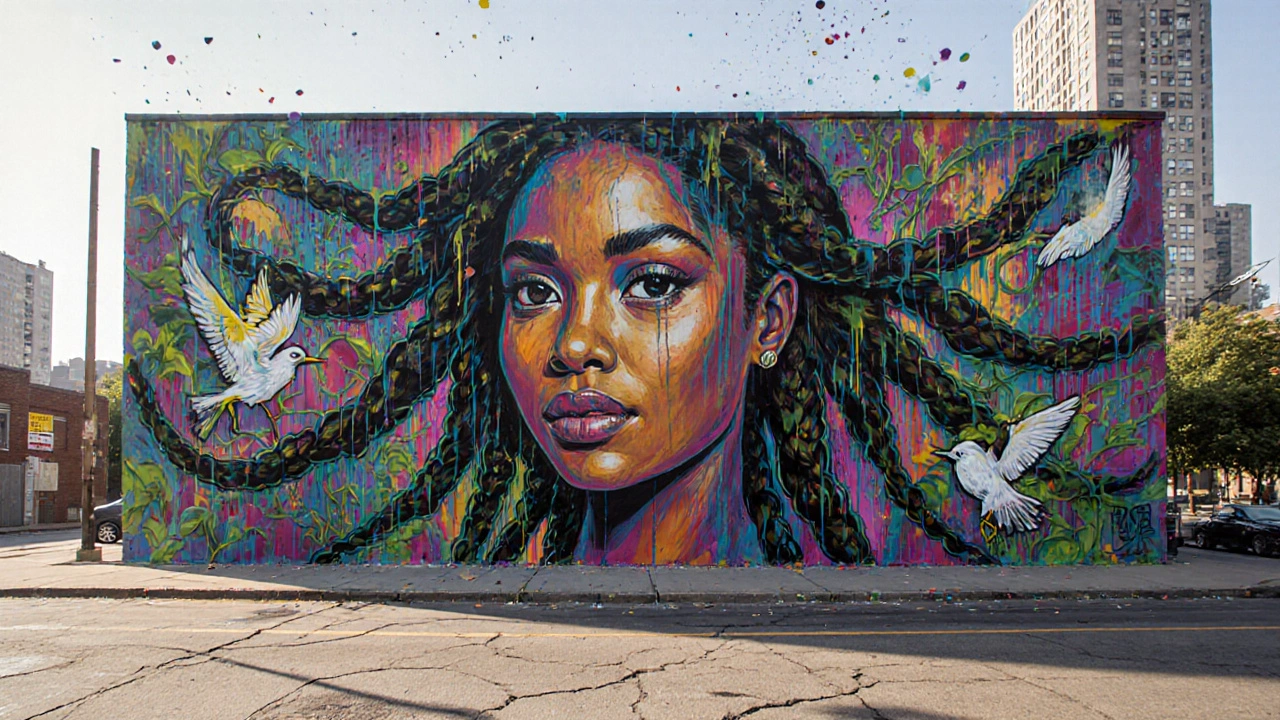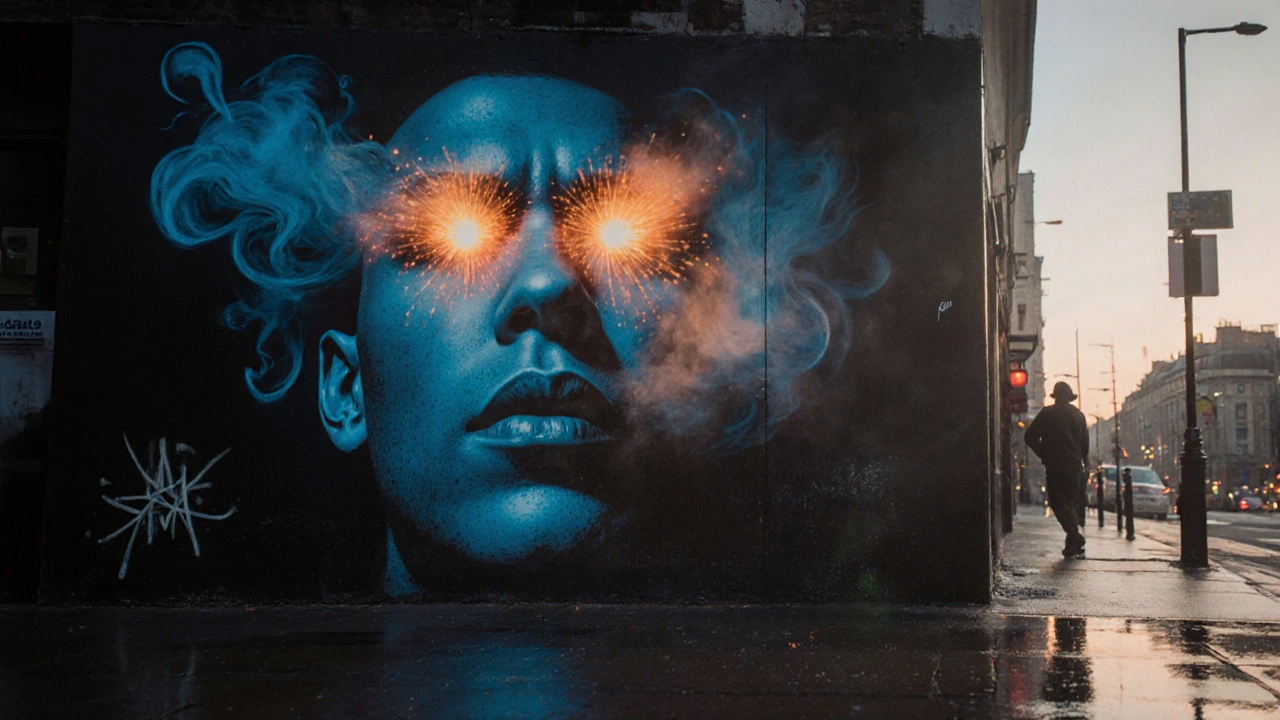
Walk through any alley in Shoreditch, Peckham, or Camden and you’ll see it - bold colors, sharp lines, and messages that stop you in your tracks. London’s street art scene isn’t just decoration. It’s history, protest, and raw creativity rolled into one. But not all of it is painted by hand. Some pieces are stamped. Others are drawn in one fluid motion. If you want to know what you’re really looking at, you need to understand the difference between stencil and freehand street art.
What Makes Stencil Art Different
Stencil art is like a reverse stamp. The artist cuts a design out of cardboard, plastic, or metal. Then they spray paint over it, leaving the shape behind. It’s fast, repeatable, and precise. You’ll spot it in places where the same image shows up again and again - like Banksy’s flying rats or the iconic Girl with Balloon in East London.
Why do artists use stencils? Speed. In a city where you can get arrested for painting on a wall, stencils let you get in, spray, and leave before anyone notices. They also allow for complex details - think facial features, text, or layered images - that would take hours to paint freehand. Banksy didn’t become famous because he painted slowly. He became famous because he could drop a powerful image on a wall in under five minutes.
Look for telltale signs: clean edges, sharp corners, and identical copies in different locations. If you see the same image on a wall in Shoreditch and another in Brixton, it’s almost certainly a stencil. Some artists even use multiple stencils, layering colors one at a time. You’ll see this in pieces by artists like ROA, who paints detailed animal silhouettes with perfect shading.
Freehand Graffiti: The Raw Energy of the Hand
Freehand graffiti is the opposite. No templates. No cuts. Just spray cans, markers, and a steady hand. Artists like D*Face, Faith47, and many local crews paint their designs directly onto walls. You’ll notice wobbly lines, drips, and imperfections - not because they’re bad, but because they’re human.
Freehand work often looks more energetic. Letters twist and swell. Figures lean and stretch. Colors bleed into each other. It’s not about precision - it’s about expression. In places like the underpass near London Bridge or the walls of the Old Street roundabout, you’ll find pieces that look like they were painted in a rush, with adrenaline and music blasting from a phone.
One of the biggest differences? Originality. A stencil can be copied. A freehand piece is one-of-a-kind. If you photograph a mural on a brick wall in Peckham and come back a week later, it might be gone - painted over, faded, or replaced. But if you spot a stencil, you can track it across the city.
Where to Find Stencil Art in London
Start in Shoreditch. The streets around Brick Lane are a living gallery. Look for Banksy’s Well Hung Lover on a wall near Hanbury Street - the figure hanging from the window is a classic stencil, with crisp outlines and layered shading. Walk a few blocks to the corner of Redchurch Street and you’ll see the Flower Thrower - a masked figure tossing a bouquet. It’s been reproduced dozens of times, but each version is still unmistakably stencil.
Another hotspot is the tunnel under the railway near Elephant & Castle. The walls here are covered in layered stencils, some political, some surreal. Look for the recurring image of a man with a briefcase full of birds - it’s by the artist known as Stik. His stick-figure people are simple, but they carry deep meaning about community and belonging.
Don’t miss the side of the building at 101-103 Kingsland Road. There’s a large stencil of a woman’s face with a crown of flowers. It’s by El Loco, a Spanish artist who’s left his mark across London. The details - the eyelashes, the shadow under the chin - are all done with stencils. No brushwork. Just layers of spray.

Where to Find Freehand Murals in London
Head to Peckham. The Rye Lane area is a canvas for freehand artists. Look for the massive mural on the side of the Peckham Library - a swirling portrait of a Black woman with braids made of vines and birds. That’s Deepest Blue, painted in 2023. The brushstrokes are visible. The colors blend in places. You can see where the artist had to step back and adjust the angle.
In Camden, the alley behind the Jazz Café is packed with freehand work. One wall features a giant skull wrapped in roses, painted by a local crew called Black Sheep Collective. The petals aren’t perfect circles - they’re slightly uneven, some fading at the edges. That’s the hand of a painter, not a machine.
Another must-see is the side of the building at 118-120 Hackney Road. A mural there shows a child holding a globe, but the globe is made of broken phone screens. The details - the cracks in the glass, the tiny faces on the screens - were all painted by hand. It took over 80 hours. No stencils were used.
How to Tell Them Apart on the Street
Here’s how to spot the difference without being an expert:
- Edges: Stencils have sharp, clean borders. Freehand has soft, uneven edges.
- Repetition: If you see the same image in three different neighborhoods, it’s a stencil.
- Texture: Freehand often has visible brush or spray texture. Stencils look flat and uniform.
- Color layers: Stencils often use 3-5 colors, applied one layer at a time. Freehand blends colors mid-spray.
- Imperfections: Drips, smudges, and shaky lines? That’s freehand. Stencils rarely have them - unless the artist added them on purpose.
Pro tip: Take a photo and zoom in. If you can see the exact same pixel-perfect shape on a wall across town, it’s stencil. If the lines look like they were drawn by a person who’s slightly tired, it’s freehand.

Why the Difference Matters
Stencil art is about message and reach. It’s designed to be copied, shared, and remembered. Banksy’s stencils go viral because they’re identical everywhere. They become symbols.
Freehand art is about presence. It’s tied to a place, a moment, a mood. It’s the kind of piece you stand in front of for five minutes, not because you’re trying to decode it, but because it feels alive. It’s the artist’s hand speaking directly to you.
London’s street art thrives because of both. One gives us icons. The other gives us intimacy.
What’s Changing in 2025
This year, something new is happening. More artists are blending the two. You’ll see a stencil base - say, a face - then freehand details added on top: tears, smoke, or glowing eyes. It’s called hybrid art. Artists like Phlegm and Julia Wachtel are doing it across East London. The stencil gives structure. The freehand adds soul.
Also, the city is getting stricter. Councils are whitewashing walls faster than ever. But that’s pushing artists to be smarter. Stencils are easier to hide. Freehand pieces are being painted on legal walls - like the new street art zone near the Tate Modern’s side entrance. It’s a protected space, opened in early 2024, where artists can paint without fear of being fined.
Final Tip: Look Closer
Don’t just walk past street art. Stop. Look up. Look down. Look at the cracks between bricks. Sometimes the best pieces are the ones you almost miss - a tiny stencil of a bird on a fire escape, or a freehand heart scribbled under a staircase. London’s street art isn’t just on walls. It’s in the gaps. And the best way to find it? Walk slowly. Look like you belong. And let the art find you.
Is Banksy’s art stencil or freehand?
Almost all of Banksy’s work is stencil. He uses layered stencils to create detailed, politically charged images quickly and consistently. His signature style - clean lines, sharp contrasts, and repeated motifs - relies on the precision stencils provide. While he may add minor freehand touches, the core of his pieces is stencil-based.
Can you tell who painted a piece just by looking at it?
Sometimes. Artists develop unique styles. Stencil artists like Stik use simple stick figures with emotional expressions. Freehand artists like Deepest Blue use bold, flowing lines and layered textures. If you’ve seen enough work, you start recognizing the hand behind the paint - whether it’s a steady stencil or a wild, freehand sweep.
Why do some street artists use stencils instead of painting freehand?
Stencils are faster, safer, and more repeatable. In a city where painting without permission can lead to fines or arrest, stencils let artists deliver complex messages in under a minute. They also allow for consistent branding - if you want your image to be recognized across multiple locations, stencils make that possible.
Are freehand murals more valuable than stencil art?
Value isn’t about technique - it’s about context. A Banksy stencil sold for over £1 million because of its cultural impact. A freehand mural by a local artist might be worth less in cash, but it’s priceless to the community that lives around it. Stencils spread ideas. Freehand murals build connection. Both matter.
Where’s the best place to see both styles side by side in London?
The area around Shoreditch and Hoxton is your best bet. Walk from Brick Lane to Redchurch Street, then down to Hoxton Square. You’ll find Banksy stencils on one wall, then a massive freehand mural of a face with glowing eyes on the next. The contrast is stark - and intentional. This stretch of London shows how both styles coexist and elevate each other.